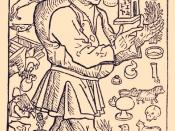Aesop. Aesop's Fables. Ed. Laura Harris. New York: Garden City Books, 1954.
Famous Greek fabulist Aesop has written Aesop's Fables. This novel contains approximately 370 fables. There are lots of stories that are known worldwide, especially The Hare and The Tortoise, The Boy Who Cries Wolf, The Old Man and Death. An interesting thing about Aesop's fables is that there is an animal character that represents a type of person in each fable. Readers need a deep concentration for every fable's lesson. Those fables are very readable, and each fable contains obvious moralities for readers to understand.
People claim that Aesop's Fable is one of the most valuable works of literature since the history of human civilization began. Lots of western fabulists used those stories as a source of subject matter. Also, Aesop's Fables are often used in famous poets and playwrights such as Aristophanes and Shakespeare. Nowadays, many artists and politicians use Aesop's Fable to prove their point of view.
Dostoevsky, Fyodor. Crime and Punishment. Ed. George Gibian. London: Norton, 1989.
Raskolnikov is a poor law student who has thought of morbid theory of role of extraordinary people and ends up killing two people. Unexpectedly, he gets a delirium and schizophrenic personality after his murder. While he is wandering, Raskolnikov meets Sofya, who is a prostitute yet has pure conscience. He falls in love with her, and with Sofya's help, he finally confesses what he has done, and he is sent to Siberia for punishment.
Dostoevsky, who is an ardent Nationalist, has written Crime and Punishment. He successfully expresses the conflict and trouble inside of the murderer with realities of society through this psychological story. Also, his expression of illness and struggling between good and evil are significant. In addition, author discarded Western Romanticism and Realism, which is...


